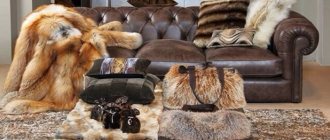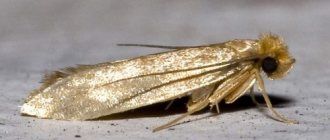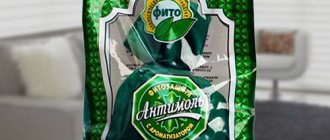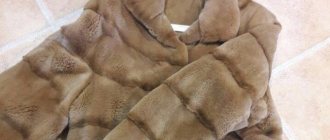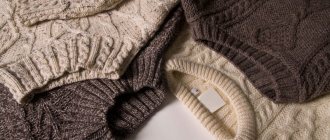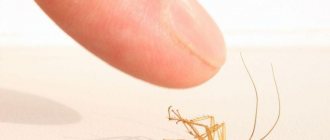The most terrible enemy of a natural fur coat is clothes and fur moths. In fact, these pests don’t care what they spoil, be it expensive fur or ordinary wool - they will all suffer to the same extent. But it is the damage to luxury winter clothing that causes the strongest wave of indignation, so every housewife should know what moth repellents exist for fur coats and how to use them to drive away the pest forever.
Description of the fur moth
There are many types of moths: clothes moth, food moth, clothes moth, grain moth. But today we will talk about the type that most upsets the female half of humanity. This is a fur moth or as it is also called a house moth. This insect feeds mainly on furs. The caterpillars are white, worm-like , naked, with eight short legs and a brown head; the body is translucent so that the insides can be seen.
The adult is sand-colored, the wings are transparent with dots in the middle, the span is about 14 - 17 mm. They live in portable cases . The adult does not have a mouthpart, so it does not feed. But it hatches larvae , which in turn spoil things. Also, female moths do not use their wings, that is, they do not fly. But the flying insects that irritate us are males. House moths are keratophages, that is, they feed on keratin , a substance that is part of the villus at the molecular level . It contains the very protein necessary for the life of an insect.
Preventive measures
Moths are attracted to worn clothes with traces of sweat and sebaceous secretions. This is why holes and abrasions often appear on cuffs, collars and other places in close contact with the skin.
The main preventive measure is frequent washing and cleaning of clothes. Dirty clothes should not be stored in the wardrobe. Attracted by the smell of greasy secretions, moths will ruin not only them, but also clean clothes hanging nearby. Items should be washed frequently or taken to dry cleaning periodically.
Thorough cleaning is also necessary for seasonal clothing and accessories sent for long-term storage: fur coats, jackets, hats, felt boots.
Some dry cleaners offer an additional service: a non-toxic anti-mole treatment that lasts for several months.
Frequent cleaning of the inside of your closet will also help protect your clothes. You need to go through your wardrobe at least once a season. Moths love secluded corners where fresh air and sunlight do not reach.
It is important to frequently rearrange clothes folded in piles: sweaters, cardigans, scarves, warm tights. Clothes on hangers should not hang too tightly; gaps should be left between items for ventilation. When going through your wardrobe, it is recommended to shake things, it is better to do this outdoors
When going through your wardrobe, it is recommended to shake things; it is better to do this outdoors.
It is useful to hang woolen items in the hot summer sun. Bright rays negatively affect moth eggs and kill already hatched caterpillars. Frost has a similar effect. Hanging fur coats, coats and suits on the balcony in sub-zero temperatures helps prevent the appearance of clothes moths.
ADVICE! At the end of the winter season, it is better for owners of expensive fur coats, fur coats and stoles to store their items in special refrigerators. This service is offered by large fur salons or dry cleaners.
Covers will help protect clothes - an excellent anti-moth remedy for fur coats. They are needed for seasonal clothing made of drape, mixed fabrics and fur, which moths especially love.
Coats, fur coats, jackets, suits and dresses are stored in covers; they are suitable for transportation and protect clothes from dust.
Products can be purchased at hardware stores (for example, the Raptor brand); the best options for storing valuable mink and sable coats are offered in specialized fur salons.
Products may be impregnated with repellent drugs. Such covers are very effective, but anti-moth impregnations are toxic and not suitable for allergy sufferers.
Soaked products should be protected from children and pets; clothes packed for storage should be placed in the closet so that they do not touch other things. It is advisable to allocate a separate section for it. Impregnated anti-moth covers remain effective for up to 12 months.
An alternative could be a product made from thick cotton or thin plastic. You can make a convenient case yourself.
The style is simple: a rectangle with a sewn bottom and a zipper along the entire length. The size depends on the length of the product; the coat or fur coat should fit into the case freely, without tucking.
Hand-sewn covers must be washed every year after the end of the storage season. They can be treated from the inside with aerosol preparations that repel moths. At home, it is better to use odorless preparations. They irrigate not only the covers, but also the walls of the wardrobe.
The best way to prevent the recurrence of food moths in the home is to be careful when purchasing groceries. It is better to purchase cereals in transparent packages so that you can visually assess their quality. Extraneous inclusions, small lumps, thin cobwebs are signs of food moth infestation.
https://www.youtube.com/watch?v=92AV4XzI4UM
It is advisable to pack all bulk products in hermetically sealed containers so that food moths cannot reach them. Cabinets need to be cleaned regularly in order to promptly get rid of stitched or insect-infested cereals. Kitchen furniture shelves should be wiped from time to time with a strong solution of vinegar, which repels food moths.
Symptoms of infection
Symptoms of moth infestation of a fur product are visible to the naked eye. The surface of the fur loses its attractiveness due to the formed lumps. Gradually, the paths and furrows eaten away by the larvae become clearly visible. The presence of pests is also indicated by the fur pile cut by them, as well as clearly visible “bald patches” on the surface of the fur product.
A moth in a fur coat does its dirty work catastrophically quickly, and any delay risks the fact that the fur coat will be irrevocably damaged.
Diet
What does a moth eat? It is worth distinguishing two food groups. The first includes direct food at home. The second includes natural products. The clothes parasite lays eggs in the nests of birds and rodents.
The larvae feed on fur or feathers shed by birds and animals. Under such conditions, their life cycle can significantly increase, since due to the lack of favorable conditions, the parasites have to overwinter in the form of pupae.
Insects are more comfortable in the house, since in addition to favorable temperature conditions, there is always cotton or woolen fabric, cereals, nuts, and tea in the home.
Why does it appear?
The reason moths appear in the house is that they feel truly comfortable here. The insect is completely satisfied with the air temperature, humidity, and most importantly, with a sufficient amount of a wide variety of food necessary for the fully formed caterpillar to make a cocoon for itself, turn into a butterfly and lay eggs.
Moths appear on fur coats and other fur products due to non-compliance with care rules. During wear, particles of sweat and dirt remain on the product - exactly what the moth larva needs for successful development.
Stages of pest development
Insect development occurs in several stages:
eggs in a dark, secluded place, for example, in a closet .
From them appear moth caterpillars , which by the time their presence is noticeable, will make a bald spot in the fur coat.
The caterpillar, when it has eaten enough and finds a secluded place, will turn into a pupa, and butterfly .
Moths in a city apartment can reproduce all year round. The normal life cycle of the pest lasts no more than 90 days.
How to detect moths on a fur coat?
It is almost impossible to detect fur moth offspring in fur products at an early stage. Moth eggs are almost invisible to the eye due to their microscopic size and translucency. With the help of a special adhesive liquid, they attach to the hairs, successfully developing into larvae, which begin to actively eat someone's mink coat.
A visual inspection is effective only when obvious damage to the product is already noticeable: lumps, folds, tunnels among the fur pile, bald spots, hairs at the bottom of the cabinet, as if neatly and evenly cut.
The main enemies of fur
All fur pests can be divided into two categories: those that eat fur (fur, wool and furniture moths, carpet beetle larvae), and those that feed on the skin of the skin (meatfly, bread beetle). The damage caused to fur products by these insects is irreparable! “Bald patches” on furs, holes in the skin and “chewed” pile (fur moth) are very noticeable both on transverse mink coats or fox vests, and on muffs, hats made of sable, astrakhan fur.
Therefore, the main rule of a caring housewife is to prevent insects from appearing in the fur, because, despite the existence of effective measures to combat them, these procedures are quite labor-intensive and are not always safe for the product.
The first signs of the presence of moths
One moth larva can “gnaw through” an entire centimeter of fabric in just a day! Therefore, in order to protect your fur coat, it is worth carefully inspecting it from time to time.
At the first sign of moths, emergency assistance is necessary. Here are some of the main obvious signs of moths on a fur coat:
• The fur is crumpled, looks dull and untidy; • There are several hairs of wool on the floor of the wardrobe; • Crumpled fur on the smooth surfaces of a fur coat; • Slightly stale smell from the product; • When ironed by hand, the villi fall out; • Small bald patches and spots are visible in the curves.
If you detect at least one such symptom, urgently free the fur from these “inhabitants”, since in the near future you risk being left without warm protection for the winter.
Optimal conditions
Those who decide to protect their fur coat from damage in the warm season in an ordinary closet should know how to properly care for the product and properly store a mink fur coat. The main conditions are described in the table.
Table - Requirements for storing mink fur coats
| Condition | Primary requirements |
| Space | — Post freely; - choose wide hangers; - purchase a fabric cover |
| Lighting | — Avoid direct sunlight |
| Temperature | — Ensure the indicator is not higher than 15°C |
| Moth protection | — Use sachets, sprays |
| Removing accessories | - Break off decorations; - remove the belt from the belt loops; - remove change from pockets |
Space and removal of accessories
First of all, you need to free up space in your storage closet.
It is important that the fur coat is not squeezed or wrinkled by neighboring items. The product should be placed on wide, durable hangers, the size of which corresponds to the size of the clothing.
The product must be fastened with all available hooks and buttons to avoid deformation.
It is best to store a mink coat in the case that comes with it upon purchase. In addition, you can purchase special covers in fur stores or regular hardware stores. The beauty of the cover is not only that it will protect the fur from mechanical damage, but also that it will protect the fur coat from moths.
Before hanging mink clothes in a case, you should remove brooches, jewelry, belts, and remove all things from your pockets. This is done so that the fur does not deform and the base does not stretch.
You cannot place a fur coat in polyethylene, since the fur will not be able to “breathe” in it. If a special cover is not available, it is better to make it from cotton fabric and attach a moth sachet inside.
Lighting and temperature
Since fur is afraid of sunlight, the place where it is stored should be dark but well ventilated. If summer hibernation occurs in a closet, its doors should be left open regularly to allow fresh air to flow into the fur.
Mink coats love the cold: the optimal temperature for them is from 5 to 15°C. It is almost impossible to achieve such conditions at home, so as an alternative, you can set the air conditioner in the dressing room to the minimum temperature or regularly take the fur coat out to the balcony for ventilation. To prevent the sun's rays from falling on the fur, the product should not be taken out of the case when airing.
Moth protection
Keeping fur away from the sun and creases is just as important as keeping a mink coat away from moths. Today there is a huge variety of substances on sale that repel butterflies and caterpillars of these insects.
Buy aerosols or sachets. But you can make anti-moth bags with your own hands by placing dry tangerine peels inside. According to reviews, you can replace citrus fruits with bergamot or lavender.
It is very important that there is no naphthalene, chemicals or their breakdown products left in the closet - this can irreversibly damage the fur. Interestingly, cedar negatively affects the condition of a mink coat, so it is important that the cabinet for storing it is not made of such wood
Knowing how to properly store a mink coat, you can wear it for more than one year. Following important but simple rules will give you the opportunity to enjoy fur clothing for ten seasons or even more.
How to prevent moths from appearing
How to keep a fur coat from moths? You can protect your clothes with effective preventive measures. First of all, this is proper storage of things. The use of fumigators, as well as special aerosols, shows good effectiveness. Spray them from time to time so that the insecticidal preparation gets on both the fur products themselves and the inner walls of the closet. Knowing how to protect clothes from moths, you can once and for all put an end to concerns about your favorite items of clothing.
Proper storage
The first thing you should pay attention to is how you can protect your home textiles from the mink pest. If a voracious insect starts in a wardrobe, it most often ends up on a fur coat made from completely different things. However, she will start eating it, and first of all, because fur is her favorite delicacy.
You can protect mink clothing if you allocate a separate closet for fur products. Separate these items from other items of clothing and pest problems should no longer arise. In this case, place clothes in the closet only in a clean, dry state. Additional protective measures will not hurt: place bags of citrus peels, geraniums or wormwood in the corners of your wardrobe. Their scent will repel vermin and keep them away from your favorite item.
What to process
What to do if there are moths in your fur coat? Sometimes, no matter what measures you take, fur products can still be attacked by these voracious insects. In this case, you cannot do without professional insecticides. If a fur coat has been eaten by moths, it is not too late to protect other items of clothing, so get rid of parasites quickly and radically.
Among the most popular compositions used against pests, it is worth highlighting aerosols: Raptor, Mosquitall. They do not have a strong odor, and you won’t have to worry about keeping things safe from pests.
Mechanical protection
If spray treatment may seem to some housewives not too gentle on fur items, you can resort to much more ancient methods - mechanical cleaning. In summer, it is recommended to shake out and ventilate the mink item. This is perhaps the most cost-effective way to preserve textiles from the harmful effects of insects. However, there are several disadvantages:
- physically, shaking up fur products is not so easy;
- You still won’t be able to rid your clothes of moth larvae this way.
Knowing how to store a product and how to protect it from insects is simply necessary for every housewife.
Folk remedies
You can remove moths from a fur coat using insecticides, but not by using folk methods alone. As a preventive measure, lavender, geranium, and citrus fruits should be placed in the wardrobe. As a rule, small fabric bags are taken for this (you can sew them yourself), into which sprigs of lavender, geranium or orange peels are placed. It is recommended to put these bags in covers for your moth coat. Remember: you are unlikely to be able to save something that has been eaten by a moth using folk remedies alone. But they are capable of repelling insects.
Insecticidal method
To prevent moths, not only scented covers are used, but also various tablets, plates, hanging fillers, and stickers. These items are soaked in essential oils, such as citrus, mint, lavender, pine and other repellent aromas. This is not harmful for us, but for insects it is a disastrous remedy. All kinds of aerosols will also help protect your fur item from parasites.
Special refrigerators
A set of measures will help protect fur clothing from moths, which includes:
- special storage;
- mechanical protection;
- folk remedies for prevention;
- chemicals.
The best option is to hand over your fur coat to one of the fur storage companies. Such companies have special refrigerators for storage: low temperature prevents the flesh from drying out on hot days and keeps the pile in good condition. But this method has several disadvantages:
- Luggage storage services are not cheap;
- this service is usually provided only in large cities;
- According to reviews from many owners who have deposited their fur coats, their appearance in the fall often leaves much to be desired, since not all organizations perform their duties efficiently.
On top of that, not every owner of a mink coat is ready to part with it for six months.
Methods of protection
Preventing moths from appearing in your wardrobe requires some effort, but prevention is guaranteed to save valuable fur from the jaws of the pest. We suggest considering several methods that will tell you how to protect your fur coat from moths.
Separate wardrobe
As a rule, an insect that eats wool products ends up on a fur coat by accident. But since these parasites are quite unpretentious in food, they begin to spoil expensive fur with great joy.
Aerosols
Use aerosol insecticides. Today there is a fairly wide selection of such products and they are easy to find on the open market. The most popular and effective are:
- Raptor;
- Mosquitall;
- Antimol;
- Armol.
They are absolutely harmless to the fur coat, do not leave any traces and do not saturate the fur with their aroma (as a last resort, you can purchase an unscented product). These brands have specially developed fur protection products that are easy to use and highly effective. The aerosol must be sprayed from time to time on the inside surface of the closet and on the fur coat itself. The frequency of this procedure can be seen in the instructions that come with each drug.
Fumigators
Fumigators are also an excellent preventive measure. They are very easy to use and do not require any physical effort on your part. To place the fumigator in the cabinet, use an extension cord.
This product repels moths very effectively, and even if for some reason a butterfly gets into the wardrobe, the device will not give it the opportunity to reproduce and the insect will soon die.
Case
Use special covers for fur coats against moths. They are made in the form of thin cases and have a reasonable price. Adult butterflies and larvae are repelled by the aroma that permeates the inner surface of the case. In addition, they close very tightly, which prevents moths from getting inside.
The most popular and effective case is the one from the Raptor brand. When producing it, the manufacturer took into account all the peculiarities of the insect’s existence, and this cover perfectly repels both adults and caterpillars.
Advice! Fur products are usually sold in covers. Save them, this will be enough if you do not have the opportunity to purchase a special case.
Post-purchase inspection
It is very important to carefully inspect it before purchasing an expensive product, since even in elite salons the fur can be contaminated. Carefully examine the fur coat for thin, long tracks of trimmed fibers. When you arrive home, you must hang it on the balcony.
Advice! You can air the fur only in absolutely dry weather, and this can be either a warm sunny day or winter frost.
Even if moth larvae already live in a new fur product, direct sunlight or low temperatures are guaranteed to destroy them.
Protective covers
When storing fur items for the summer, you need to put them in a protective cover. When purchasing a fur coat in specialized stores, such a cover usually comes included, but it can also be purchased separately.
Here we are not talking about a plastic bag, but about a special zippered cover made of air-permeable material. If you pack a fur coat in polyethylene or airtight synthetics, the product will acquire an unpleasant odor and the fur will lose its attractive appearance.
We suggest you read: Biological control of tomato leaf miner
Before packing in a case, the fur coat must first be prepared for storage:
- remove all jewelry and accessories;
- check the quality of fasteners (buttons, snaps, hooks) and the integrity of the lining and repair if necessary;
- If the fur coat has recently been exposed to rain or sleet, dry it naturally without using a hair dryer or heater;
- clean from stains and greasy contaminants on your own or take them to dry cleaning, since the smell of sweat and human sebum attracts moths.
Only after this can you put the clothes in a case and put them in the closet. Ideal storage conditions are air temperature from 0 to 19 ° C and humidity 40-50%.
In stores you can buy special protective covers impregnated with insecticidal preparations - products that repel insect pests. If the case does not have such impregnation, you should place inside the bag any of the household chemicals marked “anti-mol”, which will be discussed below.
You should not hope that a coat with impregnation is capable of 100% protecting a fur coat from small pests. Therefore, during the entire storage period, it must be regularly removed, inspected for the presence of larvae, shaken and ventilated outdoors in the shade so that the scorching rays of the sun do not fall on the product.
Actions to take if a fur product is contaminated
A product can become infected during storage in the warm season or if there are larvae in the closet or room where it is stored.
Signs of infection
The signs are easy to spot, as they are immediately obvious. This:
- A fur coat affected by moths loses its attractive appearance and lumps form on the surface.
- The folds and wrinkles that form are paths cut by the larvae.
- Trimmed fur pile.
- Formed bald patches on the surface.
- Presence of butterflies in the room where the product is located.
If you notice one or more of these signs, it is important to take action.
How to save a product
There are several ways to save a fur coat damaged by moths. If the situation is not critical:
- You can tint your bald spots to match the color of your fur.
- A small “bald spot” can be cut out, and the edges from the inside can be sewn together again.
- A spot in the chest or collar area can be decorated with a brooch.
In some situations, you can shorten the product or cut off the sleeves and make a fur vest.
How to quickly kill insects
Fur owners need to know what to do if moths have already appeared. It is necessary to destroy the larvae as quickly as possible; for this purpose, anti-moth products for fur coats are suitable, which can destroy insects in a matter of hours. After treating your fur coat with insecticidal agents, you need to put it in a plastic bag for several days or use dry cleaning services, where the product will be treated at high temperatures.
Insecticides and aerosols are effective. In special stores you can choose for every taste and budget. Raptor extramit, Armol, Clean House have proven themselves well.
It is sometimes difficult to save a mink coat, it all depends on the degree of damage to the fur. If you choose the right moth repellent for your fur coat, you can easily remove even the largest horde of insects.
Interesting read
Improper storage is also often the cause of foul smelling fur. If the product is hung in a closet damp, and even in a plastic bag, the fur may “suffocate” and a moldy smell will appear.
If the new clothes were made from raw materials that were stored in a warehouse for a long time and became damp, then this may also be the cause of the bad smell. “Stale fur coats,” as one owner of a large fur retail chain put it—these are models made from old, low-quality raw materials, or those that hung unclaimed in the store for a long time—this is one of the reasons for the smell.
White fur coat
Also, the unpleasant odor from mink fur may be associated with the anti-moth treatment that is used in stores. Usually this smell disappears on its own.
Dry the fur item thoroughly. Then fold the fur coat with the fur inward and place it in a thick plastic bag. Place the bundle in the freezer (it is advisable that there is no food in this freezer compartment), and remove it after 1-2 days. Unfold the fur coat and hang it in a dry, well-ventilated place. With the help of freezing, you can rid a fur product of even the most persistent odors.
Protect woolen items from moths
Moths spoil not only mink coats, but also any items made of mouton and natural wool. After the summer season, you can find battered hats, scarves, sweaters and dresses, which also does not add optimism and joy. You can protect such clothes if you follow a few rules:
- Store things only in clean form. The smell of sweat and various stains are considered attractive to beetles. Before packing items, they must be washed or cleaned and dried thoroughly.
- Use sealed bags, preferably vacuum ones.
- Treat clothing and the inside of the package with a special spray before packaging.
- Place a tablet/wafer or bag of lavender inside the bag.
Chemicals
Nowadays, naphthalene is no longer used, which effectively destroyed moths, but gave the product a persistent unpleasant odor. The modern chemical industry produces a huge arsenal of various anti-moth preparations in the form of:
- aerosols and sprays;
- tablets;
- special sections-plates.
Some of them have a pleasant aroma of essential oils, while others are not perceived by humans at all. Chemicals also act in different ways: some only repel insects, others destroy them.
The tablets can be laid out on the shelves of the closet or placed in the pockets of a fur coat, and the plates can be hung inside the cover with the fur coat. In this case, you need to monitor how long the drug is intended for. Typically, manufacturers indicate that after opening the package, the anti-moth is effective for 2-3 months. Therefore, during the spring-summer period you will have to change it at least twice. For greater reliability, you should not wait for the deadline, but it is better to place a new product ten days earlier.
Aerosol insecticides are considered the most effective moth repellents for fur coats. Among the huge assortment, there are several that have earned positive reviews:
- "Antimol STOP";
- "Antimol Morpheus";
- "Armol Expert";
- "Moskitol";
- “Raptor “Protection from moths””;
- "Clean house";
- "Extramit".
The listed drugs can get rid of or prevent the appearance of not only moths and their larvae, but also carpet beetles. Each can comes with detailed instructions that must be followed unconditionally. Any deviation from the manufacturer's recommendations can significantly reduce the effectiveness of the chemical. Depending on the type of preparation, it is used to treat either the fur coat itself, or the cover, or the walls of the closet.
Prevention and rules for storing fur coats
Before you send your furry beauty into “summer hibernation,” you need to carefully prepare. This will prevent the appearance of pests.
To do this, it is recommended to carry out the following activities:
- Be sure to clean the product after the end of the season. Existing traces of wear are removed by dry cleaning.
- Fix any problems with the fittings. Carry out cosmetic repairs if necessary.
- Take care of a protective anti-moth cover, which will prevent parasites from getting to the treat. Don't skimp on this accessory. You can purchase covers soaked in essential oils, which moths really don’t like.
- To prevent pests from touching the fur product, create favorable storage conditions, ventilate the product from time to time, and let it breathe.
Danger to humans
Knowing about the ability of moths to damage natural fabrics and food, you should carefully approach the choice of goods when purchasing.
Not all suppliers guarantee the quality of the product; cereals on store shelves may contain parasite larvae, and if the clan penetrates into a home, it will quickly begin to reproduce in favorable temperature conditions.
If you eat affected cereal, then in addition to the larvae in the plate, you can get severe poisoning. The fact is that at the site of parasite production, traces of their vital activity, skins and feces remain.
Therefore, to avoid ending up in a hospital in serious condition after eating cheap cereal, contaminated bags should be disposed of.
The second life of a moth-damaged fur coat
A moth has chewed on your fur coat, are you in despair, don’t know what to do with it? There is a way out of any situation, sometimes very simple, and sometimes expensive.
Before you get upset, evaluate the scale of your losses:
- If you notice minor stains on the collar, it may be enough to simply cover the flaw with a scarf or shawl.
- A chest island will hide a brooch of a suitable size, with a distracting effect.
- If the larva has damaged inconspicuous places, you can simply shade them with paint, a marker, shoe polish, just choose the tone.
- If you need to get rid of the affected areas on your fur coat, perform a small “operation”. To do this, cut out the infected areas and try to sew the incision. But first, make sure you can do it without being noticed.
- For severely damaged clothing, you may have to get creative. For example, make leather inserts, shorten the product, change the length of the sleeves, and so on. It is quite possible to recut the fur coat.
- What remains, on the one hand, is the easiest, and on the other hand, the most expensive option, when nothing can be done - buy a new fur item from a mouton or mink.
We showed a photo of what a fur coat looks like when eaten by moths, and told us how to prevent such a nuisance. Don’t let your favorite, perhaps your only, fur coat fall into disrepair. Consider the recommendations that will help you avoid the appearance and proliferation of moths in your wardrobe.
Prevention measures
Rub the fur with table salt, weak solutions of carbolic and salicylic acid, or creosote. This event must be carried out with poorly processed fur, otherwise in the summer, and even if stored improperly, the appearance of fly larvae cannot be avoided.
We invite you to familiarize yourself with: Black moth - methods of combating this insect!
Regularly hang your fur coat, hat or vest in the sun (once a month) and fresh air, clean it from dust (shake it out). Ultraviolet light and oxygen are the worst enemies of moths and their larvae.
Store fur products in dry, dark and closed areas. At the same time, do not forget about their regular ventilation and periodic washing of the walls of the room (cabinet shelves) with carbolic acid. If things are stored indoors in a folded state, then they must be sprinkled with insecticides against insects that do not have a strong odor;
Under no circumstances should you use plastic bags or other materials that do not allow air to pass through for storing fur coats, hats, muffs. Condensation (moisture) and lack of fresh air are not only a favorable environment for the reproduction of insects, but also harm the fur;
You can regularly clean the fur (combing), and if necessary, easily beat it out, using a stiff brush. This is a mandatory measure when larvae are detected.
The last procedure on the list will be especially necessary for a mink coat for a car lady, or any similar fur product that experiences increased operating loads. Combing the skin will allow you to straighten the tangled and stuck together pile and give it the right direction. The fur will look well-groomed, and the fur coat will look as if it had just been taken from a display case.
Winter: wearing rules...
Mink is capricious to wear and does not tolerate neglect. For a fur coat to remain beautiful for more than one season, it must be worn correctly. And here’s what you should pay attention to before “walking” your pet.
- Freezing. Mink loves low temperatures. Therefore, a frosty day is a great reason to take a walk in your favorite fur outfit.
- Sun. Bright sun causes the color to fade. It should be avoided so that the fur does not lose its luxurious color.
- Moisture. What happens to your hair after it rains? Same as with fur. If you suddenly get caught in wet snow, get to a warm room as soon as possible, shake off the moisture and dry your fur coat at room temperature. You can’t use a hairdryer - it will dry out the pile and leather fabric.
- Dust. Dust settles on the hairs, gets clogged into the pores of the leather fabric - the fur coat quickly loses its luster and looks untidy. If it’s already frosty, but there’s not enough snow outside, and the wind raises clouds of dust, leave your fur coat at home until better times.
- Friction. It is a nightmare for a fur coat. Even with slight but prolonged pressure, the fur wrinkles. And with constant friction, it’s even worse: the guard hair breaks, the underhair gets wiped out, and ugly bald patches appear. Therefore: we carry bags exclusively in our hands and diligently avoid crowds.
- Reagents. Mink fur is very delicate and does not tolerate exposure to aggressive substances. It is better not to walk along streets treated with reagents in a long fur coat: the route should be from the entrance to the transport and back.
